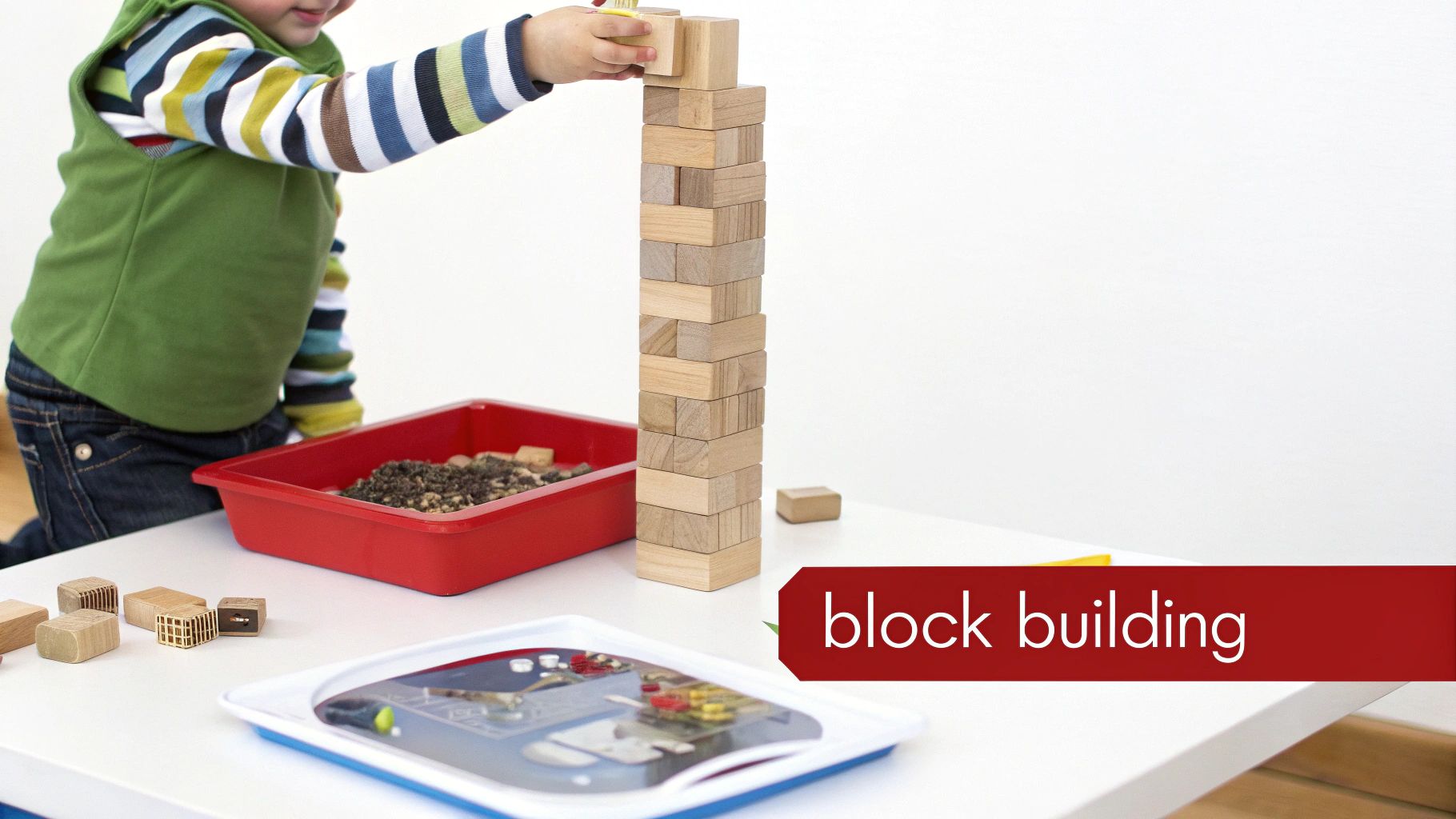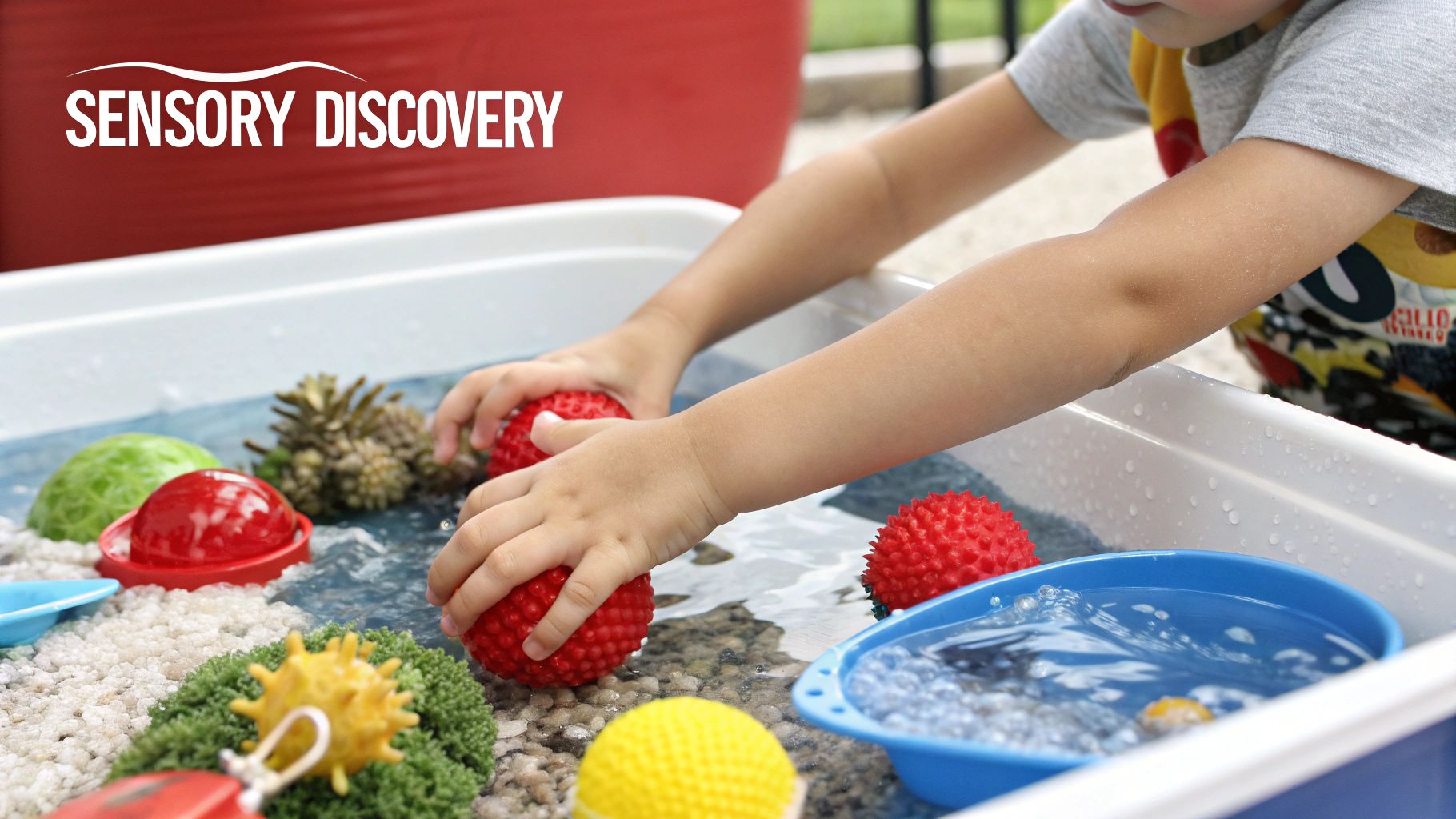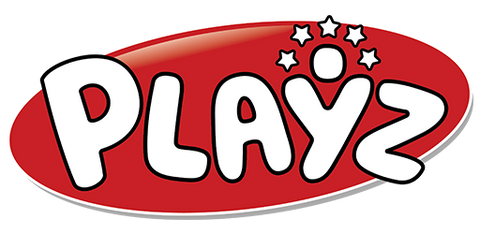
8 Powerful Learning Through Play Examples for 2025
Imagine a world where learning isn't a chore, but an exciting adventure. For children, this world is a reality, and it's called play. It’s where they build sprawling cities, travel to distant galaxies, and become heroic doctors, all while developing critical lifelong skills. But how does this magic actually translate into tangible development? This guide moves beyond simple suggestions to provide eight powerful learning through play examples, each with a strategic breakdown of the skills being built.
You'll discover the 'why' behind the fun, gaining actionable insights to foster cognitive, social, and emotional growth. We will dissect how common activities, from building with blocks to imaginative role-playing, function as sophisticated learning tools. This article is for parents, educators, and anyone looking to understand the mechanics of play-based education and turn everyday fun into foundational learning.
1. Dramatic Play & Role-Playing: The Empathy Lab
Dramatic play, a cornerstone of early childhood, involves children acting out scenarios and adopting roles. This type of play is far more than just "pretend"; it's a powerful cognitive and emotional rehearsal for life. Through role-playing as doctors, chefs, or parents, children explore social structures, practice empathy by stepping into others' shoes, and develop complex problem-solving skills in a safe, controlled environment.
This method stands out as one of the most effective learning through play examples because it integrates multiple developmental domains simultaneously. A child pretending to run a restaurant is practicing social etiquette, early math skills (counting money), literacy (writing menus), and executive functions (planning the order of service). It provides a rich, real-world context for applying academic concepts.
Why It's a Powerful Learning Tool:
- Cognitive Development: Children plan narratives, negotiate roles, and solve in-play problems, which enhances executive function and critical thinking.
- Emotional Regulation: By acting out scenarios like a visit to the doctor, children can process anxieties and learn to manage their feelings in a low-stakes setting.
- Language & Literacy: This play is rich with dialogue, storytelling, and vocabulary building. Creating signs, menus, or patient charts introduces literacy in a meaningful way.
Key Insight: Dramatic play is a rehearsal for life. It allows children to deconstruct and understand complex social interactions, rules, and emotions by actively participating in them rather than passively observing.
Actionable Takeaway: Provide the Props, Not the Script
To foster powerful dramatic play, focus on providing a prop-rich environment. Create a dedicated play space, such as a corner with a few key items. A simple set of play dishes, a doctor's kit, or a box of assorted dress-up clothes can ignite countless scenarios.
Themed play areas are highly effective. You can easily set up a veterinarian clinic, a grocery store, or even a space station. These spaces are greatly enhanced with props that encourage interaction, such as a play tent that can serve as a house, a cave, or a castle. For more ideas on how to use these versatile tools, explore the benefits of using indoor play tents to create immersive worlds. The key is to provide the "scaffolding" for imagination, then step back and let the child lead.
2. Constructive Play & Building Activities: The Mini-Engineering Firm
Constructive play is the process of creating or building things, turning raw materials into a structured whole. It’s where children manipulate their environment by stacking blocks, molding clay, or connecting LEGO bricks, transforming abstract ideas into tangible creations. This hands-on process is a fundamental way children test physical laws like gravity and balance while expressing their creativity.

This method is one of the most powerful learning through play examples because it directly engages problem-solving and spatial reasoning faculties. When a child builds a tower, they are hypothesizing, experimenting, and re-evaluating their design with each placement. This iterative process of trial and error is the very foundation of scientific thinking and engineering principles.
Why It's a Powerful Learning Tool:
- Cognitive Development: Building activities enhance spatial awareness, mathematical concepts (geometry, symmetry), and problem-solving. Children must plan, design, and execute their ideas.
- Fine Motor Skills: Manipulating small objects like LEGOs develops dexterity, hand-eye coordination, and the precise muscle control needed for writing.
- Persistence & Resilience: When a structure collapses, the child learns to manage frustration, analyze failure, and try again. This builds grit and a resilient mindset.
Key Insight: Constructive play is a micro-laboratory for innovation. It teaches children that failure is not an endpoint but a data point, encouraging them to iterate on their designs and find creative solutions.
Actionable Takeaway: Offer Open-Ended Building Materials
To cultivate rich constructive play, offer a diverse and open-ended collection of materials. Go beyond standard block sets by including loose parts like cardboard tubes, recycled containers, and natural items like sticks and stones. The goal is to provide tools, not just toys, that can be used in limitless ways.
Set up a dedicated “maker space” where projects can be left out for several days. To spark new ideas without dictating the play, use provocations like displaying a picture of a unique bridge or asking, "How can we build a home for this toy animal?" These activities are a perfect gateway to more complex topics; for inspiration, discover a wide range of engineering activities for kids that build on these foundational skills.
3. Physical & Active Play: The Brain-Boosting Gym
Physical play, encompassing everything from running on a playground to structured movement games, is fundamental to a child's holistic development. This form of play taps into a child’s natural desire to move, turning gross motor activities into powerful learning opportunities. It’s where children learn the limits and capabilities of their bodies, developing strength, balance, and coordination in a joyful, energetic context.
This type of engagement is one of the most vital learning through play examples because it directly links physical health with cognitive function. When a child navigates an obstacle course or plays tag, they aren't just exercising. They're making rapid-fire decisions, assessing spatial relationships, and learning to cooperate within a set of rules. This kinesthetic learning cements concepts in a way that sedentary activities cannot.
Why It's a Powerful Learning Tool:
- Cognitive Development: Active games require strategic thinking, spatial awareness, and problem-solving. Planning a route in a chase game enhances memory and executive function.
- Emotional Regulation: Physical exertion is a natural outlet for stress and excess energy. It helps children manage big emotions and build confidence in their physical abilities.
- Social Skills: Group games like tag or organized sports teach invaluable lessons in turn-taking, teamwork, rule-following, and good sportsmanship.
Key Insight: Physical play is brain-building. Movement stimulates blood flow to the brain, enhancing neural connectivity and improving concentration, memory, and overall academic performance.
Actionable Takeaway: Create Opportunities for Movement
Fostering high-quality physical play means creating opportunities for both structured and unstructured movement. Ensure access to safe, open spaces, whether it's a backyard, a local park, or even a cleared area indoors. Simple props like balls, jump ropes, or sidewalk chalk can inspire countless games.
For a more guided approach, set up simple obstacle courses using pillows and boxes for children to crawl under and climb over. You can also introduce classic movement games like "Simon Says" or "Red Light, Green Light," which challenge listening skills and self-control. The goal is to encourage children to push their physical boundaries safely, building both their bodies and their brains.
4. Sensory Play & Exploratory Learning: The Brain-Wiring Station
Sensory play is a foundational method of learning that involves activities designed to stimulate a child's senses: touch, smell, taste, sight, and hearing. From squishing mud between their fingers to listening to the rustle of leaves, children use their senses to gather and process information about the world. This hands-on exploration is crucial for building neural connections in the brain's pathways.

This approach is one of the most vital learning through play examples because it supports cognitive growth, language development, and emotional regulation from a very young age. Activities like sorting objects in a sensory bin help children develop complex thinking skills. It is the raw, physical data collection that underpins all abstract thought and scientific reasoning later in life.
Why It's a Powerful Learning Tool:
- Cognitive Development: Sensory exploration helps children understand attributes like size, shape, and texture. It builds a foundation for scientific inquiry by encouraging observation and experimentation.
- Emotional Regulation: Engaging activities like water play or handling kinetic sand can have a powerful calming effect on a child's nervous system, helping them manage big emotions.
- Fine & Gross Motor Skills: Pouring and scooping in sensory bins refines fine motor control, while larger activities like playing in sand or mud build gross motor strength.
Key Insight: Sensory play is not just "messy play"; it is brain-building. It provides the essential inputs the brain needs to develop complex neural pathways for learning, memory, and problem-solving.
Actionable Takeaway: Embrace the Mess with a Plan
Fostering rich sensory play is about providing diverse, safe materials and the freedom to explore. Begin with a simple sensory bin filled with rice, beans, or water. Introduce tools like scoops, funnels, and cups to encourage manipulation. Don't be afraid of mess; use a mat or take the activity outside to manage cleanup.
Integrate sensory experiences into daily routines. A nature walk can become a sensory treasure hunt. Finger painting or playing with scented dough are excellent indoor options. For a comprehensive list of ideas, discover a wide range of engaging sensory activities for kids that you can implement at home or in the classroom. The key is to offer a variety of materials that engage all their senses over time.
5. Symbolic Play & Pretend Play: The Abstract Thought Trainer
Symbolic play is the magical ability of a child to use one object to represent another, transforming a simple stick into a wizard's wand or a cardboard box into a rocket ship. This form of play is a developmental milestone where children begin to grasp that symbols can stand for real-world items and ideas. It is the bedrock of abstract thought, allowing children to create and navigate imaginary worlds.
This process is a fundamental example of learning through play examples because it directly builds the cognitive pathways necessary for literacy and numeracy. Before a child can understand that the letters "c-a-t" represent a furry animal, they first learn that a block can represent a phone. This practice of assigning meaning to objects builds the symbolic thinking skills required for all future academic learning.
Why It's a Powerful Learning Tool:
- Cognitive Development: Symbolic play strengthens abstract thinking, problem-solving, and imagination. When a child decides a leaf is a plate, they are creating mental representations.
- Literacy & Numeracy Foundations: This play is a direct precursor to understanding that letters represent sounds and numerals represent quantities.
- Creativity & Innovation: By using open-ended materials in new ways, children practice divergent thinking. There are no "wrong" answers, which fosters creative confidence.
Key Insight: Symbolic play is the brain's first language. It teaches children how to decode the world by creating their own system of meaning, a skill that is essential for interpreting the complex symbol systems of language, math, and science.
Actionable Takeaway: Provide Loose Parts for Imagination
To cultivate rich symbolic play, focus on providing open-ended materials rather than single-purpose toys. A collection of "loose parts" like stones, shells, blocks, fabric scraps, and sticks offers infinite possibilities. These materials invite children to impose their own meaning onto them.
Create an environment that encourages this exploration. Set out a tray with various natural items and observe how a child uses them. You can model this type of play by picking up a pinecone and pretending it's an ice cream cone, then ask, "What could your shell be?" The goal is not to direct the play but to spark the initial imaginative leap. Avoid toys that dictate the narrative and instead provide the raw materials for the child to build their own.
6. Games with Rules & Structured Play: The Logic and Strategy Arena
Structured play, which includes any game with a predetermined set of rules and a clear objective, is a fundamental way children learn about social contracts and logic. Activities like board games, card games, or organized sports teach children to understand and operate within a defined system. By engaging in these activities, children practice following instructions, taking turns, and managing both victory and defeat gracefully.
This approach is one of the most direct learning through play examples for teaching strategic thinking and resilience. A simple game of Uno requires children to think ahead, adapt to changing circumstances, and understand cause and effect. They learn that actions have consequences and that working within a framework is essential for achieving a goal, whether individually or as part of a team.
Why It's a Powerful Learning Tool:
- Cognitive Development: Rule-based games demand strategic thinking, memory, and pattern recognition, building critical executive function skills.
- Emotional Regulation: Learning to lose is a crucial life skill. Structured play provides a safe context to experience disappointment, practice good sportsmanship, and build emotional maturity.
- Social Skills: These games are built on cooperation and fair play. Children learn to negotiate, communicate clearly about rules, resolve conflicts, and function as part of a group.
Key Insight: Games with rules are micro-societies. They teach children that structure and guidelines are not just restrictive but are necessary frameworks that enable fair and enjoyable interaction for everyone.
Actionable Takeaway: Start Simple and Model Sportsmanship
Introduce rule-based games by starting simple and focusing on the experience rather than the outcome. Games like Go Fish or Chutes and Ladders have straightforward rules that are easy for young children to grasp. The goal is to build confidence and associate rules with fun, not frustration.
As children become more comfortable, you can gradually introduce more complex games. It's also effective to modify rules to suit the players' age and skill level. Always model good sportsmanship yourself by being a gracious winner and a supportive loser. The primary objective is to cultivate a love for strategic play and collaboration.
7. Nature Play & Outdoor Exploration: The Living Science Lab
Nature play involves children engaging directly with the natural world, from forests and gardens to local parks. This hands-on interaction goes beyond a simple walk outside; it includes unstructured activities like climbing trees, collecting leaves, or simply digging in the dirt. It's a fundamental way for children to develop a connection with their environment, fostering curiosity, respect for nature, and a sense of wonder.
This approach is one of the most powerful learning through play examples because it offers a dynamic, multi-sensory classroom without walls. Engaging with nature stimulates all the senses, promotes physical health, and provides endless opportunities for scientific discovery. A child examining a snail is learning about biology and habitats, while building a dam in a stream teaches physics principles in a tangible, memorable way.

Why It's a Powerful Learning Tool:
- Cognitive Development: Children practice observation skills, ask questions, and form hypotheses about the natural world. This builds a foundation for scientific thinking.
- Physical Health: Running, climbing, and balancing on uneven terrain develop gross motor skills, coordination, and overall physical fitness.
- Sensory Integration: Nature provides a rich tapestry of textures, sounds, and smells that helps children develop and integrate their sensory systems.
Key Insight: Nature play grounds learning in reality. It teaches cause and effect, life cycles, and ecological principles not as abstract concepts but as lived experiences, creating deeper and more lasting knowledge.
Actionable Takeaway: Let Curiosity Be the Guide
To encourage nature play, you don't need a national park in your backyard. Start by making the most of accessible green spaces. The key is to allow for unstructured exploration; let the child’s curiosity lead the way.
Equip them with simple tools like a magnifying glass or a bucket to encourage closer observation. Use seasonal changes as built-in learning opportunities, discussing why leaves change color or where animals go in winter. The immense developmental advantages of these activities are well-documented. To dive deeper, explore the many benefits of outdoor play and find more ideas for getting started. Ultimately, celebrating every discovery fosters a lifelong love for learning and the outdoors.
8. Imaginative & Fantasy Play: The Narrative-Building Workshop
Imaginative and fantasy play takes children beyond simple role-playing into the realm of complex narrative creation. Here, children invent entire worlds, develop intricate storylines, and embody characters from superheroes to mythical creatures. This form of play is a powerhouse for cognitive growth, as it demands that children construct, sustain, and collaboratively evolve detailed mental scenarios.
This method is one of the most profound learning through play examples because it directly builds the architecture for higher-order thinking. When children collaborate on a fantasy world, they are engaging in sophisticated narrative construction, practicing advanced negotiation, and expanding their vocabularies. This extended, creative engagement fosters a deep capacity for abstract thought.
Why It's a Powerful Learning Tool:
- Cognitive Development: Building fantasy worlds requires planning, sequencing events, and maintaining logical consistency within a fictional framework. This enhances executive function and narrative competence.
- Emotional Regulation: Playing as powerful superheroes or wise wizards allows children to explore concepts of justice, courage, and morality. It offers a safe outlet to process feelings of powerlessness or fear.
- Language & Literacy: This play is a crucible for vocabulary. Children create dialogue, describe fantastical settings, and often incorporate elements from stories they've read, strengthening literacy skills.
Key Insight: Fantasy play is not an escape from reality but a tool to understand it. By creating and controlling their own narratives, children develop the mental flexibility and creative problem-solving skills needed to navigate the real world.
Actionable Takeaway: Allow Stories to Evolve Over Time
To cultivate rich narrative play, provide open-ended materials that spark imagination. A box of assorted fabric scraps, natural materials, and versatile building blocks can become anything from a sorcerer's cloak to a spaceship's control panel. The goal is to provide props, not pre-written scripts.
Encourage play that spans multiple days, allowing children to develop deeper, more complex storylines. You can support this by creating a dedicated "story corner" where their creations can remain undisturbed. Providing tools like a simple notebook for "story mapping" can also elevate their play. For more ideas on tools that inspire these adventures, check out this guide to the best imaginative play toys to see how the right props can unlock incredible worlds.
Comparison of 8 Learning-Through-Play Examples
| Activity | 🔄 Implementation Complexity | ⚡ Resource Requirements | 📊 Expected Outcomes | Ideal Use Cases | ⭐ Key Advantages |
|---|---|---|---|---|---|
| Dramatic Play & Role-Playing | Medium — occasional adult facilitation to manage conflicts | Moderate — dress-up, props, dedicated space | Empathy, language, social-emotional processing | Preschool dramatic corners, therapy, social skills groups | Builds perspective-taking, communication, confidence. 💡 Provide props and observe |
| Constructive Play & Building Activities | Medium — setup/cleanup and scaffolding for challenges | Moderate–High — blocks, LEGO, maker supplies and storage | Spatial reasoning, fine motor, problem-solving, persistence | Maker spaces, STEM lessons, collaborative engineering tasks | Tangible accomplishment and STEM foundations. 💡 Offer varied open-ended materials |
| Physical/Active Play & Movement Games | Low–Medium — supervision and safety planning required | Moderate — safe play area; varied equipment optional | Gross motor skills, fitness, emotional regulation | Recess, PE, outdoor programs, motor-skills interventions | Improves health, coordination, mood. 💡 Ensure age-appropriate safety |
| Sensory Play & Exploratory Learning | Low — simple set-up but requires mess management | Low–Moderate — sensory bins, water/sand; consider allergies | Sensory processing, early cognition, self-regulation | Early childhood, occupational therapy, calming activities | Highly inclusive and regulating. 💡 Prepare for mess and observe sensitivities |
| Symbolic Play & Pretend Play with Objects | Low–Medium — depends on child's developmental level | Low — loose parts, natural materials; minimal cost | Abstract thinking, symbolic representation, literacy prep | Toddler/preschool pretend play, storytelling, early literacy | Accessible, fosters cognitive flexibility. 💡 Provide open-ended, substitutable objects |
| Games with Rules & Structured Play | Medium — requires rule teaching and scaffolding | Low — board/card games or minimal equipment | Executive function, turn-taking, strategic thinking | Classroom groups, family game nights, structured sports | Teaches self-control and strategy. 💡 Start simple and adapt rules |
| Nature Play & Outdoor Exploration | Medium — planning, risk assessment and supervision | Low–Variable — natural spaces; minimal gear but location-dependent | Physical health, resilience, environmental awareness | Forest schools, nature centers, outdoor curricula | Promotes independence and biophilia. 💡 Use seasonal learning opportunities |
| Imaginative & Fantasy Play with Narratives | Medium — may require extended time and peer coordination | Low–Moderate — story props, books, dedicated space | Advanced language, narrative skills, emotional processing | Extended play projects, literacy preparation, creative clubs | Expands vocabulary and storytelling. 💡 Allow multi-day narrative continuity |
Transforming Everyday Moments into Learning Adventures
Throughout this guide, we’ve explored a diverse landscape of play, from the collaborative storytelling of dramatic play to the scientific discovery inherent in nature exploration. These learning through play examples all point to a single, powerful truth: play is the most effective and natural engine for learning. It is not a break from education; it is education in its purest form.
The core lesson is the shift from a passive observer to an active facilitator. It's about seeing a pile of mud not as a mess, but as a sensory science lab. It's recognizing that a cardboard box is not trash, but a rocket ship fueling lessons in engineering and narrative. The power lies in creating an environment rich with possibilities and then stepping back to let curiosity lead the way.
Your Actionable Playbook for Deeper Learning
To truly harness the power of play, remember these fundamental takeaways:
- Embrace Process Over Product: The real learning isn't the finished tower; it's the trial-and-error, problem-solving, and fine-tuning of motor skills that happened during its creation. Focus on praising effort, strategy, and resilience.
- Provide Open-Ended Materials: The most effective "educational" toys are often the simplest. Items like blocks, art supplies, and natural elements can be transformed into anything, fostering greater creativity than single-purpose toys.
- Follow the Child's Lead: While structured games have their place, the most profound learning often emerges from child-led imaginative play. Observe their interests and provide resources that deepen their existing fascinations.
- Vary the Play Environment: Learning is not confined to a single room. As we've seen, physical play hones gross motor skills, while outdoor nature play builds observation skills. Regularly changing the setting introduces new variables and challenges.
The Lasting Impact of a Play-Based Approach
Mastering these concepts is a foundational investment in a child’s future. By encouraging a playful approach to challenges, you are nurturing essential life skills that extend far beyond childhood. You are building resilient problem-solvers, empathetic communicators, and innovative thinkers who are not afraid to experiment and fail.
The true value of these learning through play examples is their ability to transform everyday moments into powerful learning adventures. You are not just teaching a child to count blocks; you are teaching them the foundational principles of physics. You are not just playing make-believe; you are building the capacity for complex narrative and emotional intelligence. By championing play, you are equipping children with the curiosity, confidence, and critical thinking skills they will need to develop a lifelong passion for discovery.
Ready to supercharge your child's playtime with tools designed for discovery? Playz creates award-winning STEM kits that perfectly embody the principles of learning through play, turning complex science into hands-on, unforgettable fun. Explore our collection at Playz and give your child the gift of a playful education.
